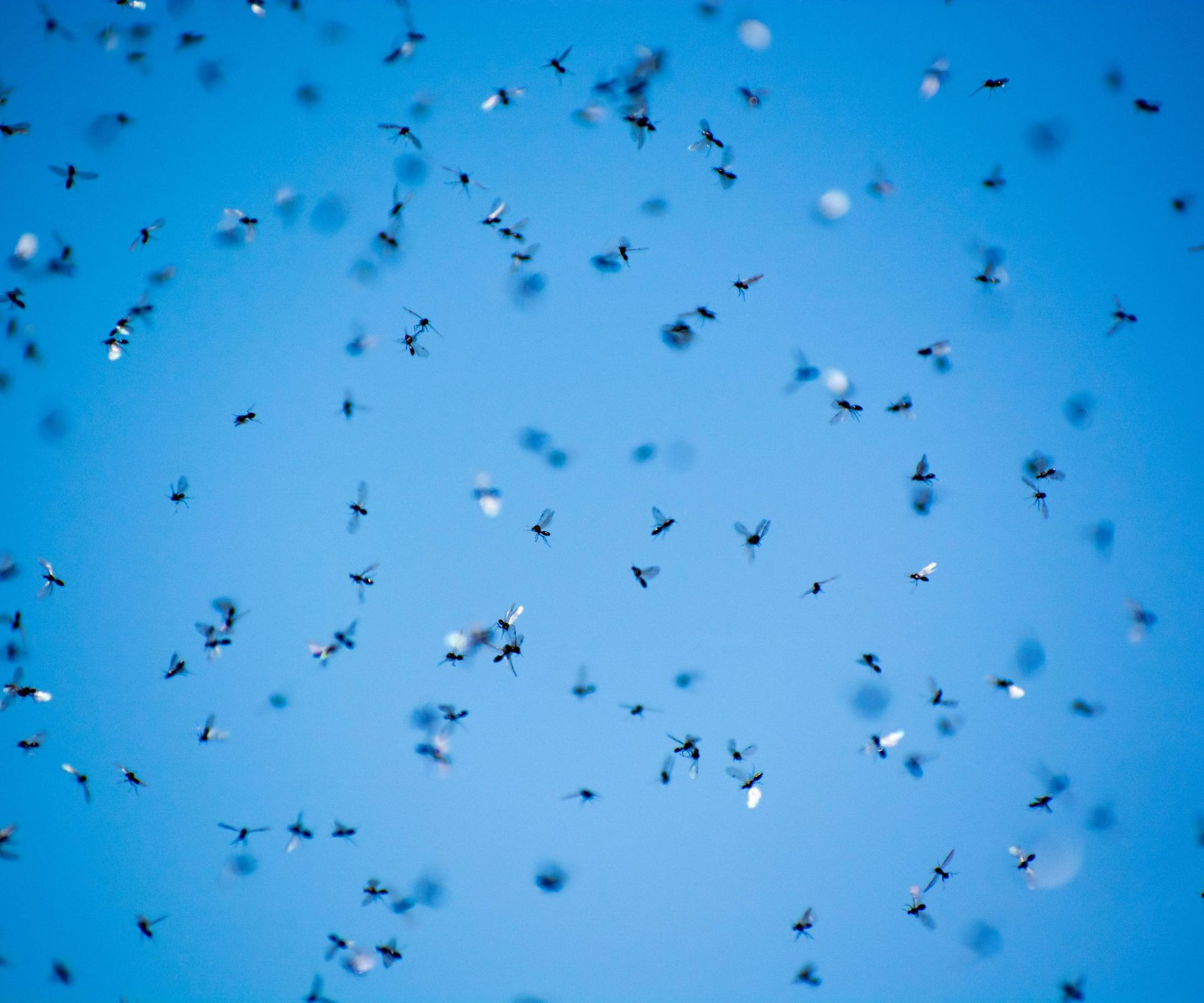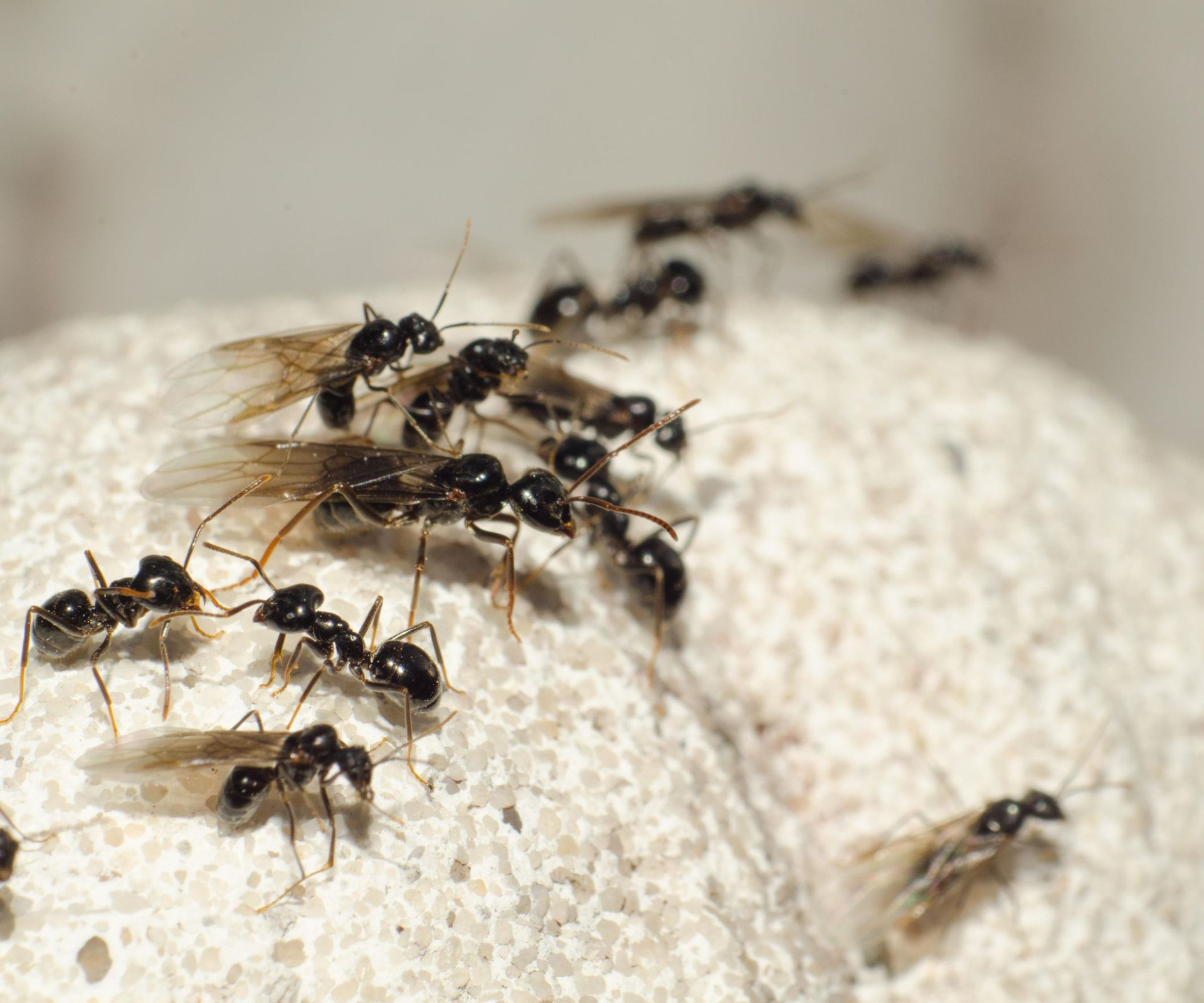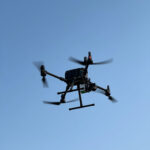Getting rid of flying ants inside the house can be a concern, but there are solutions to help. Flying ants, or alates, are reproductive members of an ant colony seeking to establish new nests, and flyermedia.net is here to provide effective strategies for managing them, preventing infestations, and ensuring your home remains pest-free. These methods include sealing entry points, using vacuums, applying safe pesticides, and, if necessary, removing the colony to achieve long-term control and safeguard your living space from these unwelcome guests, ensuring a comfortable and ant-free environment.
1. Understanding Flying Ants
Flying ants, also known as alates, are reproductive members of an ant colony that emerge to mate and establish new colonies. Identifying them correctly is the first step in effective pest control.
1.1 What Are Flying Ants?
Flying ants are winged versions of regular ants, specifically fertile males and females, that leave their nests to mate and start new colonies. According to research from the University of California, Davis, these ants typically appear in swarms on warm, humid days, often after rain, to maximize their chances of successful mating and colony establishment.
1.2 Identifying Flying Ants
It’s crucial to distinguish flying ants from termites, as both have wings and can appear similar. Key differences include:
- Antennae: Ants have bent antennae, while termites have straight antennae.
- Waist: Ants have a pinched waist, whereas termites have a broad waist.
- Wings: Ants have two sets of wings of different sizes, while termites have wings of equal size.
| Feature | Flying Ants | Termites |
|---|---|---|
| Antennae | Bent | Straight |
| Waist | Pinched | Broad |
| Wing Size | Two sets of different sizes | Two sets of equal sizes |
 Flying ants vs termites
Flying ants vs termites
1.3 Why Do Flying Ants Appear Inside Homes?
Flying ants are drawn into homes by several factors:
- Light: They are attracted to indoor lights, especially during their mating flights.
- Food: Like regular ants, they seek out food sources, particularly sweet or sugary substances.
- Shelter: Indoor spaces offer protection from predators and harsh weather conditions, making them ideal for starting a new colony.
According to the Entomological Society of America, understanding these attractants can help homeowners take preventive measures to keep flying ants out.
2. Immediate Actions to Get Rid of Flying Ants
When flying ants invade your home, quick action is essential to prevent a full-blown infestation. Here are effective immediate steps you can take.
2.1 Vacuuming
Vacuuming is one of the most effective and immediate ways to eliminate flying ants. Can vacuuming remove flying ants? Yes, using a vacuum cleaner to suck up flying ants is a fast and efficient method to reduce their numbers.
- How to Vacuum: Use a vacuum cleaner with a hose attachment to reach ants in corners, along baseboards, and near windows.
- Disposal: After vacuuming, immediately empty the vacuum bag or canister into a sealed trash bag and dispose of it outside to prevent the ants from escaping back into your home.
2.2 Using Insecticidal Sprays
Insecticidal sprays can quickly kill flying ants on contact. What are the types of insecticidal sprays? There are two primary types:
- Contact Sprays: These sprays, such as pyrethrin-based insecticides, kill ants immediately upon contact. Always follow the manufacturer’s instructions and safety precautions when using these products.
- Residual Sprays: These provide longer-lasting protection by leaving a residue that kills ants when they walk over treated surfaces. These are useful for entry points and areas where ants are frequently seen.
Always ensure proper ventilation and avoid spraying near food preparation areas. According to the EPA, proper use of insecticides is crucial for both effectiveness and safety.
2.3 Swatting or Trapping
For a small number of flying ants, swatting them with a fly swatter or using sticky traps can be effective. How do you trap flying ants?
- Fly Swatter: Simply swat the ants as you see them.
- Sticky Traps: Place sticky traps near windows, doors, and other entry points to capture flying ants.
These methods are best suited for minor infestations or as a temporary solution while you implement more comprehensive control measures.
3. Natural and DIY Solutions
For those who prefer not to use chemical insecticides, there are several natural and DIY methods to control flying ants.
3.1 Vinegar Solution
Vinegar is a natural repellent that can disrupt ants’ scent trails. How can vinegar help get rid of flying ants?
- Preparation: Mix equal parts of white vinegar and water in a spray bottle.
- Application: Spray the solution directly on flying ants or in areas where you see them frequently.
- Benefits: Vinegar is safe, non-toxic, and effective for repelling ants, making it an excellent choice for households with children and pets.
3.2 Dish Soap and Water
Dish soap can break down the exoskeleton of ants, leading to dehydration and death. How does dish soap kill flying ants?
- Preparation: Mix a few drops of dish soap with water in a spray bottle.
- Application: Spray the solution directly on flying ants. The soapy water will suffocate and kill them.
- Benefits: This solution is inexpensive, readily available, and safe for use around your home.
3.3 Essential Oils
Certain essential oils have insect-repelling properties that can deter flying ants. Which essential oils repel ants?
- Peppermint Oil: Ants dislike the strong scent of peppermint. Mix a few drops of peppermint oil with water and spray around entry points and areas where you see ants.
- Tea Tree Oil: Tea tree oil has strong insecticidal properties. Dilute a few drops with water and apply as a spray.
- Citrus Oils: Lemon, orange, and other citrus oils contain compounds that are toxic to ants. Mix citrus oil with water and spray around affected areas.
Essential oils provide a natural and fragrant way to keep flying ants at bay. A study published in the Journal of Economic Entomology found that peppermint oil is highly effective at repelling ants.
3.4 Diatomaceous Earth
Diatomaceous earth (DE) is a natural powder made from fossilized diatoms. It is safe for humans and pets but lethal to ants. How does Diatomaceous Earth work?
- Application: Sprinkle a thin layer of DE around entry points, along baseboards, and in areas where you see flying ants.
- Mechanism: DE works by damaging the ants’ exoskeletons, causing them to dehydrate and die.
- Safety: Use food-grade DE, as it is non-toxic.
DE is a long-lasting and effective solution for controlling ants naturally.
4. Finding and Eliminating the Ant Colony
To achieve long-term control of flying ants, it is essential to locate and eliminate the ant colony.
4.1 Identifying the Colony Location
Flying ants typically emerge from established colonies. Look for nests:
- Outdoors: Check under rocks, logs, and in soil around the perimeter of your home.
- Indoors: Inspect areas such as wall voids, under sinks, and in damp locations.
According to the National Pest Management Association, finding the colony is crucial for effective ant control.
4.2 Using Bait Traps
Bait traps are an effective way to eliminate ant colonies. How do bait traps work?
- Mechanism: Worker ants carry the bait back to the colony, poisoning the queen and other ants.
- Placement: Place bait traps near areas where you see ants, but out of reach of children and pets.
- Types of Baits: Common baits include sugar-based baits (for sugar-loving ants) and protein-based baits (for protein-loving ants).
4.3 Direct Treatment of the Nest
Once you locate the nest, you can treat it directly with insecticides or natural solutions.
- Insecticides: Use a liquid or dust insecticide labeled for ant control. Follow the manufacturer’s instructions carefully.
- Boiling Water: Pouring boiling water into the nest can kill the ants. This method is best for outdoor nests.
- Borax Solution: Mix borax with sugar and water, and pour the solution into the nest. Borax is toxic to ants and will eliminate the colony over time.
Direct treatment of the nest provides a targeted approach to eliminating the ant colony.
5. Preventive Measures to Keep Flying Ants Away
Prevention is key to keeping flying ants from returning to your home. Here are several preventive measures you can take.
5.1 Sealing Entry Points
Sealing cracks and crevices is essential to prevent ants from entering your home. Where should you seal entry points?
- Caulk: Use caulk to seal cracks in walls, around windows, and along baseboards.
- Weather Stripping: Install weather stripping around doors and windows to create a tight seal.
- Screen Repairs: Repair or replace damaged window and door screens.
Sealing entry points deprives ants of access to your home, making it less attractive to them.
 Sealing cracks to prevent flying ants
Sealing cracks to prevent flying ants
5.2 Maintaining Cleanliness
Keeping your home clean and free of food debris is crucial for preventing ant infestations.
- Food Storage: Store food in airtight containers to prevent ants from accessing it.
- Regular Cleaning: Clean up spills and crumbs immediately. Sweep and mop floors regularly.
- Garbage Disposal: Keep garbage cans clean and tightly sealed. Dispose of garbage regularly.
Maintaining cleanliness eliminates food sources that attract ants to your home.
5.3 Managing Moisture
Ants are attracted to moisture. Managing moisture levels in and around your home can help deter them.
- Fix Leaks: Repair any leaky pipes or faucets.
- Improve Ventilation: Ensure proper ventilation in bathrooms and kitchens to reduce humidity.
- Gutters: Keep gutters clean and free of debris to prevent water from pooling around your home’s foundation.
Controlling moisture levels makes your home less attractive to ants.
5.4 Yard Maintenance
Maintaining your yard can help prevent ants from nesting near your home.
- Remove Debris: Clear away piles of leaves, wood, and other debris that can provide nesting sites for ants.
- Trim Vegetation: Trim bushes and trees away from your home to prevent ants from using them to access your house.
- Mulch Management: Avoid using excessive mulch near your foundation, as it can retain moisture and attract ants.
Proper yard maintenance reduces potential nesting sites and makes your property less inviting to ants.
6. When to Call a Professional
While many ant infestations can be managed with DIY methods, there are situations where it is best to call a professional pest control service.
6.1 Signs of a Severe Infestation
- Large Numbers of Ants: If you see a continuous stream of ants, it may indicate a large and well-established colony.
- Multiple Colonies: Finding ants in multiple areas of your home suggests a widespread infestation.
- Persistent Problem: If you have tried DIY methods without success, it may be time to seek professional help.
6.2 Benefits of Professional Pest Control
- Expertise: Professional pest control technicians have the knowledge and experience to accurately identify ant species and develop effective treatment plans.
- Targeted Treatments: Professionals use specialized equipment and products that are not available to the general public.
- Long-Term Solutions: Pest control services can provide long-term solutions to prevent future infestations.
According to the National Pest Management Association, professional pest control is often the most effective way to eliminate severe ant infestations.
6.3 Finding a Reputable Pest Control Service
- Research: Look for pest control companies with good reviews and a strong reputation.
- Credentials: Ensure the company is licensed and insured.
- Consultation: Request a thorough inspection and a detailed treatment plan.
- Guarantees: Ask about guarantees or warranties for their services.
Choosing a reputable pest control service ensures that you receive effective and reliable treatment for your ant problem.
7. Understanding Flying Ant Season
Knowing when flying ants are most active can help you prepare and take preventive measures.
7.1 Peak Season for Flying Ants
Flying ants typically emerge during the summer months, particularly in July and August. This phenomenon is often referred to as “flying ant day,” although it can occur over several weeks.
7.2 Factors Influencing Swarming
- Weather: Warm, humid weather conditions, often after a period of rain, trigger swarming behavior.
- Temperature: Flying ants are most active when temperatures are consistently warm.
- Location: The timing of swarming can vary depending on geographic location.
7.3 Preparing for Flying Ant Season
- Seal Entry Points: Inspect and seal any cracks or crevices around your home before the start of summer.
- Maintain Cleanliness: Keep your home clean and free of food debris.
- Yard Maintenance: Clear away potential nesting sites in your yard.
- Be Vigilant: Monitor your home for signs of ant activity and take action promptly.
Preparing for flying ant season can help minimize the risk of an infestation.
8. Flying Ants and Home Damage
While flying ants themselves do not typically cause structural damage, their presence can indicate an existing problem with other wood-destroying insects.
8.1 Do Flying Ants Cause Damage?
Flying ants do not directly damage wood or other building materials. However, they can be a sign of a nearby ant colony, which may include carpenter ants that can cause structural damage.
8.2 Association with Carpenter Ants
Carpenter ants excavate wood to create nests, which can weaken wooden structures. Flying ants may be a sign of a mature carpenter ant colony that is ready to reproduce.
8.3 Inspecting for Carpenter Ant Damage
- Frass: Look for piles of sawdust-like material (frass) near wooden structures.
- Hollow Sounds: Tap on wooden surfaces to listen for hollow sounds, which may indicate carpenter ant damage.
- Visible Damage: Inspect wood for signs of tunneling or excavation.
If you suspect carpenter ant damage, it is important to contact a professional pest control service for a thorough inspection and treatment.
9. Public Health Concerns Related to Flying Ants
Flying ants do not pose a direct health risk to humans, but their presence can be a nuisance and may be associated with unsanitary conditions.
9.1 Do Flying Ants Carry Diseases?
Flying ants do not typically carry diseases that are harmful to humans. However, they can contaminate food if they come into contact with it.
9.2 Allergies and Sensitivities
Some people may be allergic to ants, including flying ants. Allergic reactions can range from mild skin irritation to more severe symptoms.
9.3 Maintaining Hygiene
- Food Safety: Store food properly and clean up spills and crumbs immediately to prevent ants from contaminating food.
- Handwashing: Wash your hands thoroughly after contact with ants or areas where they have been present.
- Waste Management: Keep garbage cans clean and tightly sealed to prevent ants from being attracted to waste.
Maintaining good hygiene practices can minimize any potential health risks associated with flying ants.
10. FAQs About Getting Rid of Flying Ants
10.1 Are Flying Ants Dangerous?
Flying ants are not dangerous to humans or pets. They do not bite or sting, and they do not carry diseases. However, their presence can be a nuisance.
10.2 Why Are There So Many Flying Ants in My House?
The presence of many flying ants in your house indicates that there is a mature ant colony nearby. They are likely attracted to light, food, or shelter.
10.3 How Long Do Flying Ants Last?
Flying ant swarms typically last for a few hours to a few days. However, the exact duration can vary depending on weather conditions and other factors.
10.4 Can Flying Ants Start a New Colony Indoors?
Yes, flying ants can start a new colony indoors if they find a suitable nesting site with access to food and water.
10.5 What Attracts Flying Ants to My Home?
Flying ants are attracted to light, food, moisture, and shelter.
10.6 Is It Normal to See Flying Ants in My House?
Seeing a few flying ants in your house is not uncommon, especially during swarming season. However, a large number of flying ants may indicate a more significant infestation.
10.7 Do Flying Ants Mean You Have Regular Ants?
Yes, flying ants are reproductive members of an ant colony. Their presence indicates that there is likely an established colony nearby.
10.8 What Time of Year Do Flying Ants Come Out?
Flying ants typically emerge during the summer months, particularly in July and August.
10.9 What Is the Best Way to Kill Flying Ants?
The best way to kill flying ants is to vacuum them up or spray them with an insecticidal solution. To prevent them from returning, it is important to locate and eliminate the ant colony.
10.10 Are Flying Ants a Sign of a Dirty House?
While a dirty house can attract ants, flying ants can appear in even the cleanest homes. They are primarily attracted to light and shelter, so keeping your home clean is just one part of preventing infestations.
By understanding flying ants and implementing effective control and prevention strategies, you can keep your home free from these unwelcome pests. Visit flyermedia.net for more information and resources on pest control and home maintenance.
Disclaimer: Always follow safety instructions when using any pest control products. Consult a professional if you have a severe infestation.
Are you ready to take control of your skies? Visit flyermedia.net today to explore pilot training programs, stay updated with the latest aviation news, and discover exciting career opportunities in the aviation industry. Your journey to the skies starts here. Address: 600 S Clyde Morris Blvd, Daytona Beach, FL 32114, United States. Phone: +1 (386) 226-6000.
